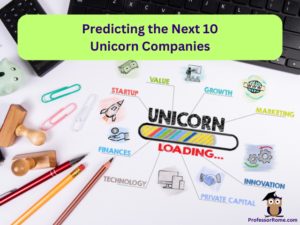
What is a unicorn company?
A unicorn company is a privately held startup company valued at over $1B USD. The term was first coined by the founder and managing partner of Cowboy Ventures, Aileen Lee in 2013, choosing the mythical animal to represent the statistical rarity of such successful ventures.
Characteristics of unicorn companies
Unicorn companies typically share several characteristics, including:
- Massive growth potential: Unicorn companies are typically growing at a very rapid pace, often doubling or even tripling their revenue in a year.
- Innovative business models: Unicorn companies are often disrupting traditional industries with new and innovative business models.
- Strong leadership: Unicorn companies are typically led by visionary and experienced entrepreneurs.
- Large addressable market: Unicorn companies are often targeting large and growing markets, which gives them the potential to achieve significant scale.

Why unicorn companies are important
Unicorn companies are important for several reasons:
- Economic drivers: Unicorn companies create jobs, attract investment, and generate economic growth.
- Innovation hubs: Unicorn companies attract top talent and create ecosystems of innovation.
- Changing the world: Unicorn companies are often disrupting traditional industries and creating new products and services that are changing the way we live and work.
Examples of unicorn companies
As of June 2022, CB Insights identified 1,170 unicorns worldwide. Some of the most famous unicorn companies include:
- SpaceX: A space exploration company founded by Elon Musk.
- Robinhood: A financial services company that provides commission-free stock trading.
- Instacart: A grocery delivery company.
- Airbnb: A platform that allows people to rent out their homes and apartments.
- Uber: A ride-hailing company.

The future of unicorn companies
The future of unicorn companies is uncertain, but they are likely to continue to play an important role in the global economy. The number of unicorn companies is expected to continue to grow, and they are likely to become even more disruptive and innovative.
Predicting the next 10 unicorn companies is a challenging task, as it requires an understanding of the current market trends, emerging technologies, and the potential for these companies to disrupt their respective industries. However, based on available information and expert insights, here are 10 companies that have the potential to achieve unicorn status in the near future:
- Affinity: Affinity is a cloud-based identity and access management (IAM) platform that simplifies user access to cloud applications. It has a strong customer base and is well-positioned to capitalize on the growing demand for IAM solutions. Affinity started in 2014 and is headquartered in San Francisco, CA. Affinity’s estimated annual revenue is $45.1M. (Growjo)
- HackerRank: HackerRank is a technical assessment and recruitment platform that helps companies find and hire top tech talent. It has a large network of developers and is used by some of the world’s leading companies. HackerRank first started in India in July 2009. HackerRank’s peak revenue was $29M in 2022. (Zippia)
- Brightline: Brightline is a high-speed rail project that will connect Miami, Orlando, and Tampa, Florida. It is expected to revolutionize transportation in the region and has the potential to create a new economic corridor. Brightline began in 2018 and is located in Florida. Brightline’s estimated annual revenue is $121M. (Growjo)
- Typeform: Typeform is a conversational form builder that makes it easy to create engaging and interactive forms. It is used by businesses of all sizes and has the potential to become the standard for online forms. Typeform was founded in 2012 and is headquartered in Barcelona, Spain. Typeform’s estimated annual revenue is $163.3M. (Growjo)
- N-able: Enable is a platform that helps businesses automate their compliance processes. It has a strong customer base and is well-positioned to capitalize on the growing demand for compliance automation solutions. N-able was founded in 2000 in Ottawa, Canada. N-able’s revenue is $409.22M. (Stock Analysis)
- May Mobility: May Mobility is an autonomous vehicle startup that is developing self-driving shuttles for public transportation. It has a strong partnership with Toyota and is well-positioned to capitalize on the growing demand for autonomous vehicles. May Mobility was established in 2017 in Ann Arbor, MI. May Mobility’s annual revenue is $4.2M. (Zippia)
- Datafold: Datafold is a data observability platform that helps businesses monitor and manage their data pipelines. It has a strong customer base and is well-positioned to capitalize on the growing demand for data observability solutions. Datafold was founded in 2020 and is headquartered in New York, NY. Datafold’s estimated annual revenue is $3.7M. (Growjo)
- Denali Ai: Denali Ai is a data platform that helps businesses build and deploy machine learning models. It has a strong customer base and is well-positioned to capitalize on the growing demand for machine-learning solutions. Denali Ai was founded in 1992 and is headquartered in Redmond, WA. Denali Ai’s annual revenue is $1.5B. (Zippia)
- Airbyte: Airbyte is a data ingestion platform that helps businesses collect and unify data from multiple sources. It has a strong customer base and is well-positioned to capitalize on the growing demand for data ingestion solutions. Airbyte was founded in 2020 and is headquartered in San Francisco, CA. Airbyte’s annual revenue is less than $1M. (Forbes)
- BigID: BigID is a data intelligence platform that helps businesses identify and manage their sensitive data. It has a strong customer base and is well-positioned to capitalize on the growing demand for data intelligence solutions. BigID started in 2016 and is based in New York, NY. BigID’s estimated annual income is $147.2M. (Growjo)
Please note that this is just a list of potential unicorn companies, and there is no guarantee that any of these companies will achieve unicorn status. However, they are all companies that are disrupting their respective industries and have the potential to achieve significant growth in the coming years.
**The content of this blog post was generated by Google Bard. All information was vetted and cited by Professor Rome.



0 Comments